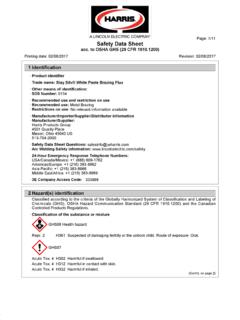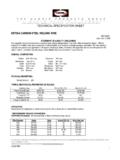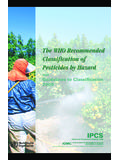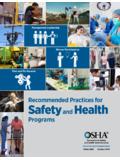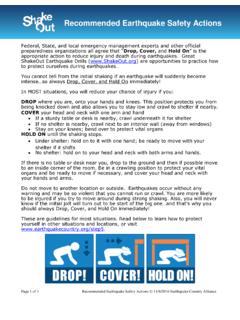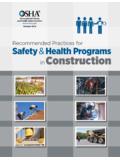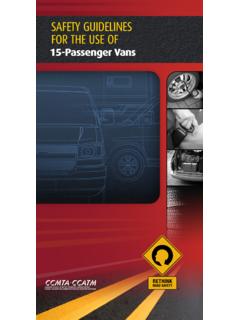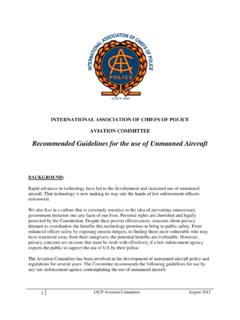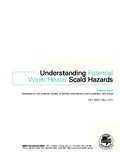Transcription of Equipment Operation SAFETY GUIDELINES
1 IT S YOUR LIFE .. Preserve it with SafetyThis SAFETY bulletin illustrates causes of industrial accidents withtorches, hoses and regulator and shows the two ways in which theseaccidents can be prevented:1. SAFE HANDLING OF TORCHES, REGULATORS, AND CYLINDERS2. USE OF AVAILABLE MODERN SAFETY EQUIPMENTR emember, SAFETY is a full-time responsibility. Accidents don t need tohappen. Understanding their cause and cure is the best prevention. BLOWN REGULATORS ..Illustrate the type of serious accidents which can cause injury, losttime, liability, property damage, and administrative headaches. Thisis a typical accident that frequently occurs and can be incorrectly mixed within the regulator and hose create anexplosive mixture which can subsequent explosion is violent and injuries come from both theflames and the disintegrating EXPLOSIVE FORCE ..Resulting from the incorrectly mixed gases which are lighted can betremendous.
2 Regulators can rupture. The letter, reprinted on thispage, describes an accident where an oxygen cylinder exploded: A recent explosion of a single oxygen bottle killed three men and injuredthirty others. The top of the bottle was found high in the plant roof; thebottom was buried deep in the ground. The center portion disintegrated in the form of shrapnel. More frequently, the incorrectly mixed gases ignite in the hose; theinjury to the operator is a burn. However, oxygen and fuel gas burnat 4000 -6000 F, so the burn injury frequently is IS A FULL-TIME RESPONSIBILITYThe accidents described so far could all have been prevented if theoxygen and fuel gas had been kept separated. The gases cannotcause trouble when correctly used. For example, each travels fromits cylinder through its regulator and hose into the torch, and onlybecome mixed in either a specially designed mixing chamber withinthe torch itself or in the tip.
3 Danger occurs only when mixing takesplace in some area other than the correct START A FIRE ..You must have three things: fuel, oxygen and ignition. No two will burn example, a popular fire extinguisheris filled with carbon dioxide. It puts outa fire by smothering it. Smotheringmeans it prevents atmospheric air,which has a 21% oxygen content, fromgetting to the flames. Without theoxygen, the fire extinguishes the other hand, you can t have a fire without fuel. An automobilewon t run on an empty gas tank. Finally, a combustible mixture isn tdangerous until it s lighted. Mixed gases in a hose or regulator aren thazardous until they re lighted. This ignition can occur several OperationSAFETY GUIDELINESREVERSE FLOW CAUSES ..Reverse flow caused by unequal pressures can result in mixed gasesin hoses and flow can happen when:1. The oxygen cylinder empties in use and with the oxygen needlevalve on the torch opened, fuel gas can reverse flow into theoxygen hose and Both cylinder valves are closed with unequal pressures in theregulators and the torch valves closed.
4 If the operator opens bothtorch needle valves simultaneously to bleed off the oxygen andfuel gas, typically higher pressure oxygen may reverse flow intothe typically lower pressure fuel gas hose, regulator andupstream gas The operator opens both torch valves and attempts to light bothgases at once. If more oxygen is flowing than can flow throughthe tip, the system is back-pressured and oxygen can reverseflow into the fuel gas hose and reverse flow, two of the three ingredients necessary for a fireare present. All that is lacking is the source of REVERSE FLOW ..puts mixed gases into the oxygen hose and regulator, an explosivemixture may result which could cause serious personal injury or The oxygen torch valve is opened and the mixed gases meet thefuel gas The cylinder valve of an oxygen regulator with pressure up to2,400 psi is quickly opened and the heat of recompression (approx 2000 F) raises the mixed gases to ignition REVERSE FLOW.
5 Has put mixed gases into the fuel gas hose and regulator, a dangerousexplosion can occur when:1. The fuel gas torch valve is opened and gases are lighted before themixed gases are completely bled off. With a small tip this can beseveral ACCIDENTS ..can be prevented if the Equipment is properly An oxygen cylinder never should be completely emptied. It shouldbe considered empty when the pressure drops to approximately50 The operator should always independently bleed his hoses beforelighting the torch. This bleeds off any combustible mixture thatmay be The operator should never light both gases at once. The onlyexception is a universal pressure torch. Universal pressureequipment is designed to prevent reverse flow, except when thetip is Equipment must be in good condition. If a torch tip is plugged, thehigher pressure gas will always back up into the lower pressure TORCHES ARE CORRECTLY USED.
6 Accidents won t happen. However, all of us occasionally are years of field experience have shown the various oxy-fuel gastorches to be reliably safe pieces of Equipment when operated inaccordance with the instructions recommended by the certain circumstances, the users fail to follow these to follow these instructions can cause the backflow of unwantedgas into the hose lines. Flash-guard check valves can provide a measure of protection toprevent reverse flow. To maintain this protection, a routine inspectionprogram must be followed to ensure that the check valves are stillfunctional. These are available in two styles. The torch type ismounted on the torch and fits any torch with standard hoseconnections. Their large capacity flows enough volume to cut 12 steel plate or handle Harris largest heating torch. These are preferredfor stopping REVERSE FLOW at the point of origin.
7 They are easilytested and easily regulator type is mounted on the regulator outlet nipple. Theyhave the same capacity as the torch type, and their effective servicelife is expected to be longer than the torch type. This is because theyare subject to less abuse and installed in a clean area (upstream of thehoses). They effectively prevent REVERSE FLOW into the regulator andcylinder and prevent dangerous quantities of mixed gases fromentering into the hoses. These are sometimes preferred for thepractical value of longer service check valves open wide for full flow at only four ounces ofpressure; but if REVERSE FLOW starts, the valve closes instantly. Eachvalve is individually tested at the Harris factory for positive shut-off atonly 10 ounces of THEY WORK ..Check valves are designed to stop REVERSE FLOW. They are notdesigned to stop a flame. However, many Equipment fires andexplosions are caused by reverse flow.
8 Check valves stop troublebefore it starts by stopping reverse flow the moment it systems using oxygen and fuel gases, in accordance withNFPA-51, will require back flow checkvalves independent of anyinstalled on CHECK VALVES ..We are frequently asked why check valves are not built into thetorches. The reason is Harris Flash-Guard Check Valves aremanufactured for a recommended 5 years service life. They should bechecked regularly, at least every 6 months. They should be replacedif found ADDITIONAL PROTECTION ..especially in situations where check valves fail to function properlydue to abuse or failure to perform periodic inspection andmaintenance, Harris Flashguard Flashback Arrestors should beinstalled. Flashback arrestors offer an additional measure ofprotection from accidents caused by reverse SAFETY FEATURES IN ONE UNIT.
9 Gives the added measure of SAFETY . First, flashback arrestors includea built-in check valve to prevent reverse flow, the major cause offlashback explosions. Second, they have incorporated, in the sameunit, a soutered metal filter to extinguish the flame should a flashbackoccur due to the failure of a check valve or some other suchunpreventible AND TORCH MOUNTED ..versions of flashback arrestors are available. Torch types are mountedon the torch inlets and fit any torch with standard B type hoseconnections. These are preferred because they offer protection at themost common point of origin. They are easily seen and offerprotection from hose explosions, a very common occurrence inequipment of this regulator type is mounted on the regulator outlet nipple. Theeffective service life of this type is generally longer because they aresubject to less abuse, and are installed in the clean area upstream ofthe hoses.
10 They are sometimes preferred when the extra weightand/or inconvenience of the torch type cannot be tolerated. Theyeffectively protect the regulator and the gas supply system and insome instances includethermal shutoff devices reducing certainhazards associated with hose CAPACITIES ..of Harris Flashguard Flashback Arrestors are high enough to cutup to ten inches steel plate when used properly. Operating pressuresmust be increased slightly, however, to compensate for pressure dropsthrough the SHOULD BE USED ..however, when selecting or using any device such as flashbackarrestors on oxy-fuel Equipment requiring large volumes of gases towork properly and safely. Large cutting tips and heavy heatingequipment are extremely sensitive to flow restrictions created by add-on Equipment . Always remember to read the manufacturer sinstructions and/or contact a properly trained representative whenusing this type of FLASHBACK ARRESTORS AT REGULAR INTERVALS.
